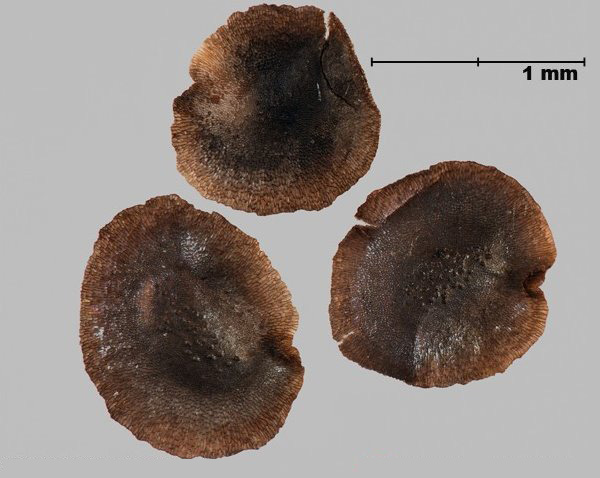Weed Seed: Linaria vulgaris (Common toadflax/Butter-and-eggs)
Family
Plantaginaceae
Common Name
Yellow toadflax
Regulation
Primary Noxious, Class 2 in the Canadian Weed Seeds Order, 2016 under the Seeds Act.
Distribution
Canadian: Occurs across Canada except in NU (Brouillet et al. 2016Footnote 1).
Worldwide: Native to Europe and temperate Asia (USDA-ARS 2016Footnote 2) and introduced in North America, Chile, South Africa, Australia and New Zealand (CABI 2016Footnote 3).
Duration of life cycle
Perennial
Seed or fruit type
Seed
Identification features
Size
- Seed length: 1.7 - 2.5 mm
- Seed width: 1.5 - 2.3 mm
Shape
- Seed round to oval with a wing around the outside; flattened
Surface Texture
- The centre of the seed is covered with tubercles
Colour
- Seed black with bronze highlights
Other Features
- A thin wing surrounds the seed, 0.3 - 1.0 mm wide, minutely reticulated
Habitat and Crop Association
Cultivated fields, old fields, pastures, rangelands, shores, roadsides and disturbed areas (Saner et al. 1995Footnote 4, Darbyshire 2003Footnote 5). In Canada, it is a problem in pastures and crops such as wheat, barley, oats, canola and peas (Saner et al. 1995Footnote 4, CABI 2016Footnote 3).
General Information
Yellow toadflax was once grown as an ornamental, dye and medicinal plant (Saner et al. 1995Footnote 4). This species first appeared in Ontario and Quebec at the end of the 19th century and moved into the Prairie Provinces after 1920, through contaminated alfalfa seed and as a garden plant (Saner et al. 1995Footnote 4). Yellow toadflax is a prolific seed producer and reproduces from both seed and clonal propagation (Saner et al. 1995Footnote 4).
Similar species
Melancholy toadflax (Linaria tristis)
- This species has rounded, flattened seeds that are a similar size and colour to yellow toadflax.
- Melancholy toadflax may be smooth or have a few tubercles like yellow toadflax, but only on one side of the seed.
Photos



Similar species


- Date modified: